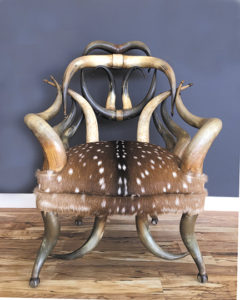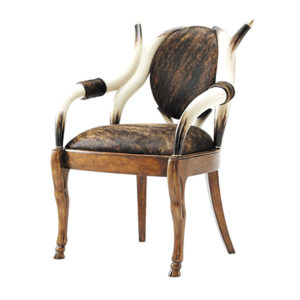 By Anne Gilbert
By Anne Gilbert While furniture using animal horn and hide may upset animal lovers these days, there was a time when it was a decorative status symbol and costly.
Furniture and decorative horn accessories were made in Germany as early as 1833. They came to international interest when it was displayed at the 1851 Crystal Palace Exhibit in London. Its popularity grew and by the end of the 19th century it was practically mass produced in the Midwest using horns from the longhorn cattle that found their way to slaughter houses in Chicago and Kansas City.
It rated a serious second class when the Toby Furniture of Chicago displayed upholstered chairs and sofas with horn arms at the Chicago Industrial Exposition in 1876. Soon they added horn legs and backs for parlor furniture. By the 1890s it was made in large quantities by Wolf, Sayer & Heller, of Chicago. They added decorative accessories such as hall racks, clock holders and small tables.
Popularity moved to the East where another new trend, hunting lodges and mountain cabins was taking place. It seemed the perfect furniture conjuring up images of the old west and the disappearing frontier.
It was finally made in the West in 1880 by Frederich Wenzel in San Antonio. However, much was still imported from Topeka, Kansas where it was being made in 1886 by a quality furniture maker, Charles Calwell of Topeka.
In a letter to the Kansas Museum of History Calwell described how he began making longhorn furniture, after he saw examples by Wenzel. Calwell and his family participated in making early pieces for family use. His wife polished the horns. Many of these pieces are now in the Kansas Museum of History.
When longhorns became scarce around 1900 that marked the end of horn furniture. Until recently it has been forgotten and out of fashion.
 CLUES: These days it is costly when it makes a rare auction or dealer appearance. They are a popular conversation piece as well as decorative for mountain homes and revived interest in rustic cabins. Many of the pieces are quite handsome with imaginative uses of the horns and animal hides.
CLUES: These days it is costly when it makes a rare auction or dealer appearance. They are a popular conversation piece as well as decorative for mountain homes and revived interest in rustic cabins. Many of the pieces are quite handsome with imaginative uses of the horns and animal hides. Reproductions are being made using acrylic horns and simulated animal fabrics. They aren’t cheap costing as much as $2,000.
For quality early examples an original, early armchair can have a dealer price of over $4,000. If the piece is also unique, a dealer price for a rocker can be over $8,000.
The good news is that so many were made, and sturdy, they can still turn up in basements and barns. PHOTO CAPTION: (1) Horn cabin armchair made in Austria. PHOTO CREDIT: 1ST DIBS PHOTO CAPTION: (2) Contemporary, repro. French acrylic horn armchair. PHOTO CREDIT: 1ST DIBS















Follow Us